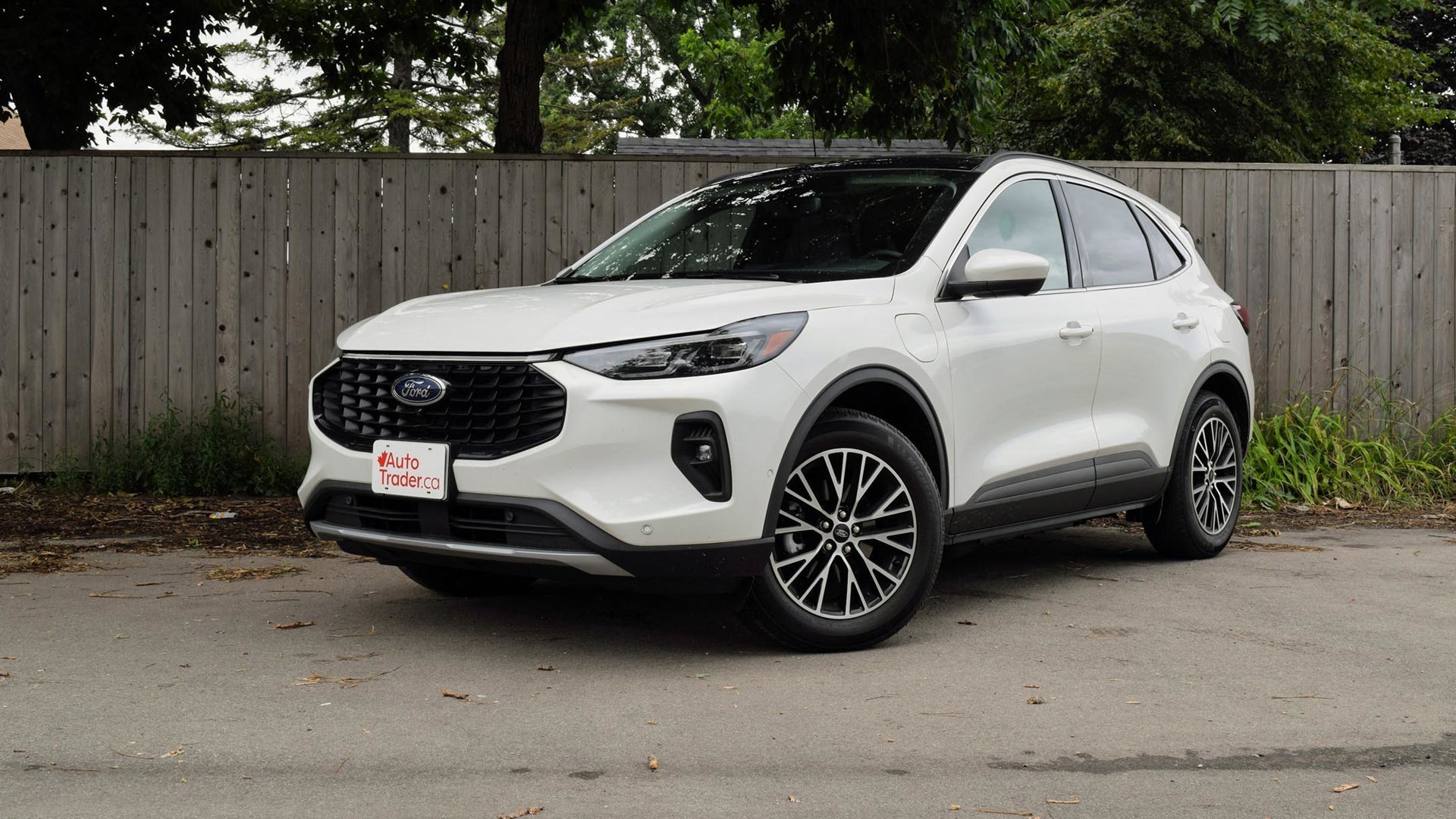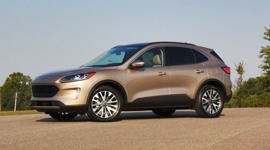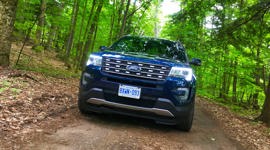 AutoTrader SCORE
AutoTrader SCORE
-
STYLING7/10
-
Safety7/10
-
PRACTICALITY7/10
-
USER-FRIENDLINESS7/10
-
FEATURES8/10
-
POWER6/10
-
COMFORT7/10
-
DRIVING FEEL7/10
-
FUEL ECONOMY8/10
-
VALUE7/10
Ford’s recent focus on the rugged Bronco Sport has stolen the spotlight from its restyled sibling, the Escape.
The similarly sized – but differently shaped – crossovers share many similarities, including a platform and base powertrains, although their executions are entirely different. Where the Bronco Sport is rugged and adventurous, the Escape is more affordable and offers a pair of gas-electric powertrains to pick from.
The 2024 Ford Escape PHEV pairs those components with a 14-kWh battery pack to deliver 60 km of emissions-free range, and even more savings thanks to federal and provincial rebates.
Styling: 7/10
Subtle updates to the front end tell this refreshed version apart. An illuminated strip now runs across the top of the grille, unifying the headlights like a glitzy unibrow. The rear lights have also been updated, but the rest looks mostly the same as the inoffensive-looking crossover that was introduced about four years ago.
Safety: 7/10
The plug-in hybrid (PHEV) version of the Escape arrives with adaptive cruise control, lane keeping assist, and a forward collision warning. There’s also a post-crash emergency alert system in the unfortunate case of a collision. Features like self-parking and low-speed reverse automatic emergency braking come with the optional Premium package ($4,900).
Practicality: 7.5/10
Open the power tailgate and you’ll find 974 L of storage behind the rear seats. That’s a bit less than the 1,061 L offered by the non-hybrid Escape, but it’s more than the Hyundai Tucson PHEV (902 L) and the Toyota RAV4 Prime (949 L.) Fold the rear seats and there’s 1,721 L.
User-Friendliness: 7.5/10
Another highlight of the Escape is its ease of use. It makes all the functions you might need easily accessible without being too simple or hiding them deep within touchscreen menus. The display measures 13.2 inches and is easy to reach and activate. It also includes support for wireless Apple CarPlay and Android Auto. There were no issues with the functionality during this test.
Features: 8.5/10
Standard equipment includes heated front seats, a heated steering wheel, and dual-zone climate control. If you opt for the Premium pack, there’s a head-up display, surround-view parking cameras, parking sensors, a wireless phone charging pad, rain-sensing wipers, and a 10-speaker sound system.
Power: 6.5/10
Ford made a few sacrifices in designing this 210-hp PHEV powertrain. For starters, this Escape is only available with front-wheel drive, putting it at a disadvantage next to rivals like the Tucson, Sportage, and RAV4. It’s also underpowered compared to all three of those PHEVs.
While the power delivery is good, the 2.5L four-cylinder engine can get uncomfortably loud during urgent acceleration. The builtin battery hold function that’s supposed to save energy for later use also didn’t operate as expected during this test, killing some of the capacity even when activated.
Comfort: 7/10
That extra noise is the only concern regarding the comfortability of the Escape PHEV. While it rides well and doesn’t crash or thud on the road, the powertrain is loud and distracting. The seats are more on the plush side than supportive.
Driving Feel: 7/10
The Escape PHEV retains most of its relatively responsive driving manners, but it’s still behind some other sharp drivers in its class like the Mazda CX-5 and Toyota RAV4. Overall, this Ford tackles corners with confidence and limited wobbliness as it maintains its composure during braking. Steering is perhaps the weakest area, feeling a bit insulated.
Fuel Economy: 8/10
The efficiency of the Escape is its best feature. It returns a combined 2.3 Le/100 km on a full battery. The all-electric range of the Escape hovers around the 60 km mark thanks to a 14-kWh battery, suggesting Ford’s gambit for efficiency over traction paid off. During testing, it averaged about 57 km on a charge, and juicing up the crossover on a standard household outlet took about 11 hours, which can be cut to about four hours by using a Level 2 charger. Even when the battery is depleted, fuel consumption is rated at 6.0 L/100 km.
Value: 7/10
With a starting price of $46,999 and a $2,095 destination fee, the 2024 Ford Escape PHEV is about $7,000 more than the most affordable conventional hybrid version of this crossover. While it’s front-wheel drive-only, it’s significantly cheaper than the RAV4 Prime and the Tucson PHEV.
This tester included the $4,900 Premium pack, an optional, extra-cost paint finish, a panoramic sunroof, and a trailer hitch, bringing the sticker price to $57,694 before tax. But then this PHEV qualifies for federal and provincial incentives that can knock the price down even further.
The Verdict
The highlights of the 2024 Ford Escape PHEV are its fuel economy, practicality, and approachable pricing. The rest makes it a little average, especially with rivals that offer stand-out features. The RAV4 Prime has tons of power, the Mitsubishi Outlander PHEV has three rows of seats, and Hyundai and Kia’s entries offer style and features. The Escape is efficient, but it’s hard to look past the front-wheel drive-only and low output figures, which limits its broad appeal. But if it comes down to budget – or rivals aren’t available – the Escape makes for an adequate substitute.
| Engine Displacement | 2.5L engine + 62 kW motor |
|---|---|
| Engine Cylinders | I4 + dual electric motors |
| Peak Horsepower | 210 hp @ 6,600 rpm |
| Peak Torque | 155 lb-ft @ 4,600 rpm |
| Fuel Economy | 5.6 / 6.3 / 5.9 L/100 km cty/hwy/cmb; 2.3 Le/100 km, 20.6 kWh/100 km cmb, 60 km est. range |
| Cargo Space | 974 / 1 722 L seats down |
| Model Tested | 2024 Ford Escape Plug-in Hybrid |
| Base Price | $46,999 |
| A/C Tax | $100 |
| Destination Fee | $2,195 |
| Price as Tested | $57,794 |
|
Optional Equipment
$8,500 – Star White Metallic Tri-Coat paint, $800; Panoramic sunroof, $1,850; Floor liners w/ carpet mats, $250; Class II tow package, $700; PHEV Premium package, $4,900
|
|







































